La alfabetización de la lengua nahuatl
The alphabetization of the Nahuatl language represents the first European experiment in the transformation of an American language into a literary language, an experiment realized in a fashion parallel to the first studies of the European vernaculars. This alphabetization was realized in a long process from the earliest contacts to the middle of the 17th century. It is possible to discern at least three stages. The first corresponds to the period which immediately folows the conquest (1523–1547). All efforts were concentrated at the time on the learning of the language, a learning without precedent, resulting in its being cast in the Procrustian bed of the orthographic conventions of Castillian. The goal was not proper alphabetization. The second stage (1547–1595) corresponds to a period in the deepening of the knowledge of Nahuatl, a process reflected in the first ‘artes’ or treatises and vocabularies. This improved knowledge of the language led to the realization that a more appropriate orthography was required. The third and final stage in the alphabetization of Nahuatl (1595–1673) is characterized by linguistic research which no doubt has its antecedents in the investigation of other ‘exotic’ languages and which is aimed at an improved analysis of this language of Mexico. The orthographic endeavours are now directed toward a reform of the writing system which includes the introduction of new characters in an attempt to capture the phonological particularities of Nahuatl. From this history of the long process of alphabetization, it is evident that a detailed analysis of the phonological descriptions and the orthographic principles conserved in the treatises until 1673 not only allows us to appreciate the achievements of these early linguists but also provides us with valuable information about the phonological system of classical Nahuatl as well as of Castillian of the period.
Article language: Spanish
References
Bibliografia
Alarcos Llorach, Emilio
1981 Fonología española. Madrid: Gredos.

Alonso, Amado
1969 De la pronunciación medieval a la moderna en español. Madrid: Gredos.

Andrews, J. Richard
1975 Introduction to Classical Nahuatl. Austin: Univ. of Texas Press.

Barret, W.
1956 “
The phonemic interpretation of accent in Father Rincon’s Arte Mexicano”.
General Linguistics 21. 22–28.

Bright, William
1960 “
Accent in Classical Aztec”
International Journal of American Linguistics 261.66–68.


Carochi, Horacio
1892 Arte de la lengua mexicana con declaración de los adverbios della. México: Museo Nacional.

Clavijero, Francico Xavier
1974 Reglas de la lengua mexicana con un vocabulario. Edición de
Arthur J. O. Anderson. México: U.N.A.M.

Davila Garibi, J. Ignacio
1935 “
La escritura del idioma náhuatl a través de los siglos”.
Investigaciones Lingüísticas 31: 1–2. 3–57.

Galdo Guzman, Diego de
1642 Arte mexicano. México: Viuda de Bernardo Calderón.

Galdo Guzman, Diego de
1890 “
Arte mexicano”. Suplemento de
Anales del Museo Nacional. México.

Garcia Icazbalceta, Jaoquín
1954 Bibliografía mexicana del siglo XVI. Revisada y ampliada por
Agustín Millares Carlo. México: F.C.E.

Garibay, K., Angel, M.a
1943 “
Huehuetlatolli. Documento A.”.
Tlalocan I1: 1–2. 31–53 y 81–107.

Garibay, K., Angel, Ma
1971 Historia de la literatura náhuatl. 21 tomos. México: Porrúa.

Gonzalez Casanova, Pablo
1932 “
El alfabeto mexicano y su valor fonético”.
Memorias del XX Congreso Internacional de Americanistas 31. 151–159. Río de Janeiro. (Recogido en
Gonzalez Casanova 1977:3–15).

Gonzalez Casanova, Pablo
1977 Estudios de Lingüística y Filología nahuas. Edición de Ascensión
H. de León-Portilla. México: U.N.A.M.

Grass, Roland
1965 “
America’s first linguists: their objetives and methods”.
Hispania 481. 57–66.


Hasler, Juan
1954 “
Las palabras acentuadas en nahua”
Archivos nahuas 1: 1. 18–23.

Lapesa, Rafael
1980 Historia de la Lengua Española. Madrid: Gredos.

Lenhart, J. M.
1926 Languages studies in the Franciscan Order. (
= Franciscan Studies, n° 5.) Nueva York.

Leon, Martín de
1611 Camino del Cielo en Lengua Mexicana…. México: Diego López Dávalos.

Leon Portilla, Ascensión H. de
1972 “
Bibliografía lingüística nahua”.
Estudios de Cultura Nahuatl 101. 409–441.

Mendieta, Jerónimo de
1973 Historia Eclesiástica Indiana; edición de
F. Solano y
Pérez-Lila, 21 tomos. (
Biblioteca de Autores Españoles, CCLX-CCLXI.) Madrid: Atlas.

Molina, Alonso de
1945 Are de la Lengua Mexicana y Castellana: edición facsimilar de la de 1571. Madrid: Ediciones de Cultura Hispánica.

Molina, Alonso de
1977 Vocabulario en lengua mexicana y castellana y castellana y mexicana. Edición fascsimilar de la fascimilaria de
Julius Platzmann (1880) de la de 1571 México: Porrúa.

Nebrija, Antonio de
1980 Gramática de la lengua casellana. Estudio y edición de
Antonio Quilis. Madrid: Editora Nacional.

Olmos, Andrés de
1972 Arte para aprender la lengua mexicana; edición facsimilar de la de
Rémi Siméon de 1875 Guadalajara (Jalisco): Edmundo Aviña Levy.

Ricard, Robert
1933 La conquête spirituelle du Mexique. París: Institut d’Ethnologie.

Rincon, Antonio del
1885 Arte Mexicana. Edición de
Antonio Peñafiel. México: Secretaría del Fomento.

Rowe, John Howland
1974 “
Sixteenth and Seventeenth Century Grammars”.
Studies in the History of Linguistics. Traditions and Paradigms ed. por
Dell Hymes, 361–379. Bloomington: Indiana Univ. Press, sity Press.

Seler, Eduard
1913 “
Das Manuscrit Mexicain Nr. 22 der Bibliothèque Nationale de Paris”.
Sitzungsberichte der kgl. preussischen Akademie der Wissenschaften, Mitteilungen aus der Sitzung der phil.-hist. Klasse, LIII1, pp. 1029–1050. Berlín.

Torquemada, Juan de
1975 Veinte i un Libros rituales i monarchia indiana. Edición facsimilar de la de 1723, 31 tomos. México: Porrúa.

Vetancurt, Agustín de
1673 Arte de la lengua mexicana. México: Francisco Rodríguez Lupercio.

Vetancurt, Agustín de
1901 “
Arte de la lengua mexicana”.
Biblioteca Mexicana Histórica y Lingüística, cuadernos 1–4. México: Museo Nacional.

Viñaza, Conde de la
1977 Bibliografía española de lenguas indígenas de América;, edición facsimilar de la de 1892. Madrid: Atlas.

Cited by
Cited by 1 other publications
This list is based on CrossRef data as of 3 july 2024. Please note that it may not be complete. Sources presented here have been supplied by the respective publishers.
Any errors therein should be reported to them.
